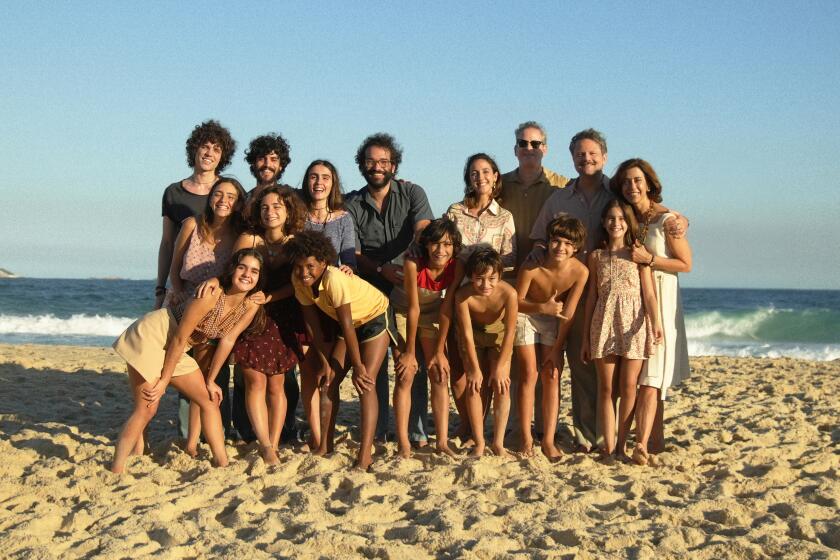
- Share via
In producing RaMell Ross’ debut documentary, “Hale County This Morning, This Evening,” I came to appreciate the extraordinary patience he’d acquired in making images, which allows the camera to act as an extension of consciousness.
RaMell’s intuition that the best way of presenting the lives of Black people in a film would be to let viewers experience them, insofar as was possible, felt smart to me, especially if we agree that race is a social construct manufactured by design.
So when we read Colson Whitehead’s remarkable novel “The Nickel Boys,” which was offered to us by Plan B to adapt as a director-producer team, I found it organic to RaMell’s process — if daunting in practice — that he would propose the entire film be shot in what he calls the “sentient perspective,” which on the script page for simplicity’s sake, we referred to as “POV,” though it went further and deeper than that.
‘The Order’ writer Zach Baylin discovered unexpected ties to a white supremacist terrorist organization’s 1984 murder of Denver radio host Alan Berg while researching the screenplay.
How to get past the conditioning we all have of being voyeurs? How to entice the viewer into entering the eyes of the main characters ? How would the experience of entering someone else’s gaze also transform the way the other people in the film look back at — (them) — us?
RaMell proposed to set about reorganizing and juxtaposing symbols of Blackness and Black life in the hope of creating a visceral interaction between the viewer and the lives unfurling onscreen. I understood this cinematic grammar, which resists transitional narrative as a structural strategy and suspends what he calls “conclusive imagining,” and he asked me to co-write with him. The other producers agreed to this, and also to our instinct that there should be no onscreen violence to avoid reinscribing the trauma-imaging that audiences are so conditioned to, especially as it regards Black people. We felt that we could respect the experience of violence that real people lived by acknowledging it through engaging every viewer’s own imaginative capacity.
We wrote the treatment as an edit first, because the specificity of images, narrative, archival and adjacent would do much of the labor of the storytelling, and a significant portion of the dialogue became distilled into image movements to further create an experience. As the treatment then expanded into a screenplay, the narrative scenes served to develop the characters and their evolution across the film while the story unfolded. Adjacent images deepened interiority.
Archival images extended the imaginative world and conveyed the actual investigation the main character in the film undertakes as revelations are made about the Nickel Academy’s brutal legacy. These included actual archival images from and about the Dozier School for Boys in Florida, the real-life “reform school” that inspired Colson’s novel and the film’s story. We crafted the final montage sequence in the script, having started the archival research during the treatment period; but we wrestled with the end of the film, in conversation with the other producers across three drafts, until we finally zeroed in.

RaMell proposed that we shoot only “oners,” single shots that were from a single point perspective, longer durationally, where there would be no coverage to ground the viewer in clock time. This concept evolved during photography as RaMell and our director of photography, Jomo Fray, deepened this approach with the development of thrown gazes (emotionally attentive macro shots). From a script standpoint, this meant that we were constructing images, scenes and entire sequences with an emphasis on duration.
The way the script is written is meant to invite the viewer into the story through an experience of seeing, understanding and feeling, penetrating the consciousness of each character, using an expansive visual and sonic language, and strong narrative beats to synergize the other pillar element — Agape, or as Dr. Martin Luther King Jr. described it, divine love operating in the human heart. A selfless love.
The transfer of love was our throughline of emotional coherence, rather than plot: from Elwood’s grandmother Hattie to Elwood; to Elwood’s receptivity to Dr. King’s message of Agape and the call of the civil rights movement; from a maturing Elwood to cynical Turner, his eventual best friend; to Turner’s gradual transformation at Nickel, which inspires a courageous and selfless act.
In a film where time moves simultaneously forward and backward, recognizing becomes more important than knowing. When we remember, from a neurological and experiential standpoint, we’re not recovering something lost but allowing the experience of loss to multiply connections. Ideally, this also makes us more receptive to echoes and transformations across the different time periods the film encompasses.
This structuring approach allows us to work with fragments, history as montage. But as John Berger noted long ago, isn’t this also how reality is made? If we don’t agree on how those pieces go together, we are inhabiting different realities, which feels ever more the case.
Participating in creating reality, seeing ourselves differently as we ourselves are seen in the returned gaze, hopefully makes fate more vulnerable, and is the very origin of art. It is the collaboration, and in the case of “Nickel Boys,” our respectful invitation.
More to Read
From the Oscars to the Emmys.
Get the Envelope newsletter for exclusive awards season coverage, behind-the-scenes stories from the Envelope podcast and columnist Glenn Whipp’s must-read analysis.
You may occasionally receive promotional content from the Los Angeles Times.









